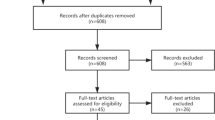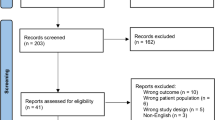Abstract
Purpose
Several studies have reported a risk of dislocation in obese patients after total hip arthroplasty. In this study, we evaluated the interaction between obesity and dislocation by kinematic analysis using a navigation system.
Methods
The intraoperative range of motion (ROM) and postoperative impingement-free ROM were measured in 38 patients, and we compared the impingement-free ROM in obese and non obese patients.
Results
The postoperatively simulated ROM was similar in the obese and non obese groups. The intraoperative ROM was smaller in the obese group. The difference values between the intraoperative ROM and postoperatively simulated ROM were larger in the obese group. These results indicate that obese patients have less ROM following primary total hip arthroplasty even when the implant positioning is performed correctly.
Conclusions
Dislocations are multifactorial problems including soft tissue impingement. Therefore, the risk of dislocation caused by soft tissue impingement in obese patients may be increased.
Similar content being viewed by others
References
Korner J, Eberle MA (2001) An update on the science and therapy of obesity and its relationship to osteoarthritis. Curr Rheumatol Rep 3(2):101–106
Flegal KM, Carroll MD, Ogden CL, Johnson CL (2002) Prevalence and trends in obesity among US adults, 1999–2000. JAMA 288(14):1723–1727
Grant JA, Viens N, Bolognesi MP, Olson SA, Cook CE (2008) Two-year outcomes in primary THA in obese male veterans administration medical center patients. Rheumatol Int 28(11):1105–1109. doi:10.1007/s00296-008-0575-y
Ibrahim SA, Stone RA, Han X, Cohen P, Fine MJ, Henderson WG, Khuri SF, Kwoh CK (2005) Racial/ethnic differences in surgical outcomes in veterans following knee or hip arthroplasty. Arthritis Rheum 52(10):3143–3151. doi:10.1002/art.21304
Felson DT, Chaisson CE (1997) Understanding the relationship between body weight and osteoarthritis. Baillieres Clin Rheumatol 11(4):671–681
Lievense AM, Bierma-Zeinstra SM, Verhagen AP, van Baar ME, Verhaar JA, Koes BW (2002) Influence of obesity on the development of osteoarthritis of the hip: a systematic review. Rheumatology (Oxford) 41(10):1155–1162
Oliveria SA, Felson DT, Cirillo PA, Reed JI, Walker AM (1999) Body weight, body mass index, and incident symptomatic osteoarthritis of the hand, hip, and knee. Epidemiology 10(2):161–166
Flugsrud GB, Nordsletten L, Espehaug B, Havelin LI, Meyer HE (2002) Risk factors for total hip replacement due to primary osteoarthritis: a cohort study in 50,034 persons. Arthritis Rheum 46(3):675–682. doi:10.1002/art.10115
Karlson EW, Mandl LA, Aweh GN, Sangha O, Liang MH, Grodstein F (2003) Total hip replacement due to osteoarthritis: the importance of age, obesity, and other modifiable risk factors. Am J Med 114(2):93–98
Felson DT (2004) Risk factors for osteoarthritis: understanding joint vulnerability. Clin Orthop Relat Res (427 Suppl):S16–S21
Hulens M, Vansant G, Lysens R, Claessens AL, Muls E, Brumagne S (2001) Study of differences in peripheral muscle strength of lean versus obese women: an allometric approach. Int J Obes Relat Metab Disord 25(5):676–681. doi:10.1038/sj.ijo.0801560
Hunter DJ, March L, Sambrook PN (2002) Knee osteoarthritis: the influence of environmental factors. Clin Exp Rheumatol 20(1):93–100
Sturmer T, Dreinhofer K, Grober-Gratz D, Brenner H, Dieppe P, Puhl W, Gunther KP (2005) Differences in the views of orthopaedic surgeons and referring practitioners on the determinants of outcome after total hip replacement. J Bone Joint Surg Br 87(10):1416–1419. doi:10.1302/0301-620X.87B10.16702
Moran M, Walmsley P, Gray A, Brenkel IJ (2005) Does body mass index affect the early outcome of primary total hip arthroplasty? J Arthroplasty 20(7):866–869. doi:10.1016/j.arth.2005.02.008
Andrew JG, Palan J, Kurup HV, Gibson P, Murray DW, Beard DJ (2008) Obesity in total hip replacement. J Bone Joint Surg Br 90(4):424–429. doi:10.1302/0301-620X.90B4.20522
Sadr Azodi O, Adami J, Lindstrom D, Eriksson KO, Wladis A, Bellocco R (2008) High body mass index is associated with increased risk of implant dislocation following primary total hip replacement: 2,106 patients followed for up to 8 years. Acta Orthop 79(1):141–147. doi:10.1080/17453670710014897
Miki H, Yamanashi W, Nishii T, Sato Y, Yoshikawa H, Sugano N (2007) Anatomic hip range of motion after implantation during total hip arthroplasty as measured by a navigation system. J Arthroplasty 22(7):946–952. doi:10.1016/j.arth.2007.02.004
Chen PY, Wu CT, Hou CH, Hou SM (2005) Loosening of total hip arthroplasty with a prosthesis employing a skirted femoral head. J Formos Med Assoc 104(5):370–373
Shon WY, Baldini T, Peterson MG, Wright TM, Salvati EA (2005) Impingement in total hip arthroplasty a study of retrieved acetabular components. J Arthroplasty 20(4):427–435. doi:10.1016/j.arth.2004.09.058
Barrack RL (2003) Dislocation after total hip arthroplasty: implant design and orientation. J Am Acad Orthop Surg 11(2):89–99
Gambera D, Carta S, Crainz E, Fortina M, Maniscalco P, Ferrata P (2002) Metallosis due to impingement between the socket and the femoral head in a total hip prosthesis. A case report. Acta Biomed 73(5–6):85–91
Gelber AC (2003) Obesity and hip osteoarthritis: the weight of the evidence is increasing. Am J Med 114(2):158–159
Park W, Ramachandran J, Weisman P, Jung ES (2010) Obesity effect on male active joint range of motion. Ergonomics 53(1):102–108. doi:10.1080/00140130903311617
Gadinsky NE, Ehrhardt JK, Urband C, Westrich GH (2011) Effect of body mass index on range of motion and manipulation after total knee arthroplasty. J Arthroplasty 26(8):1194–1197. doi:10.1016/j.arth.2010.12.004
Elkins JM, Daniel M, Pedersen DR, Singh B, Yack HJ, Callaghan JJ, Brown TD (2012) Morbid obesity may increase dislocation in total hip patients: a biomechanical analysis. Clin Orthop Relat Res. doi:10.1007/s11999-012-2512-3
Lubbeke A, Stern R, Garavaglia G, Zurcher L, Hoffmeyer P (2007) Differences in outcomes of obese women and men undergoing primary total hip arthroplasty. Arthritis Rheum 57(2):327–334. doi:10.1002/art.22542
Lewinnek GE, Lewis JL, Tarr R, Compere CL, Zimmerman JR (1978) Dislocations after total hip-replacement arthroplasties. J Bone Joint Surg Am 60(2):217–220
Author information
Authors and Affiliations
Corresponding author
Rights and permissions
About this article
Cite this article
Hayashi, S., Nishiyama, T., Fujishiro, T. et al. Obese patients may have more soft tissue impingement following primary total hip arthroplasty. International Orthopaedics (SICOT) 36, 2419–2423 (2012). https://doi.org/10.1007/s00264-012-1701-8
Received:
Accepted:
Published:
Issue Date:
DOI: https://doi.org/10.1007/s00264-012-1701-8




